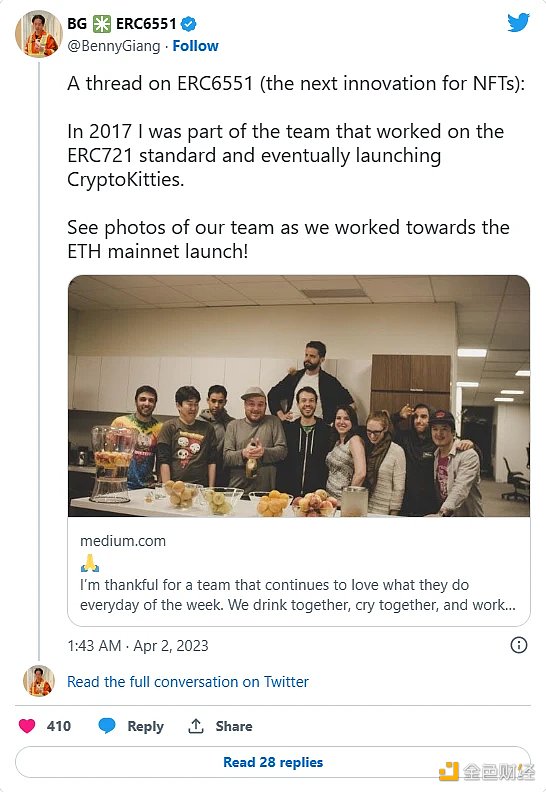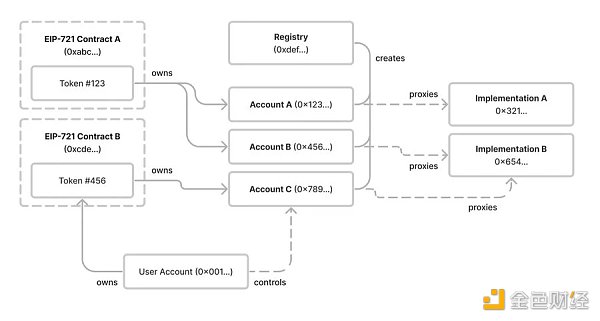Understanding ERC-6551 in one article: How to change the rules of NFT gaming?
ERC-6551: Changing NFT Game RulesAuthor: Ivan Cryptoslav, CoinMarketCap Translator: hiiro, SevenUp DAO Developer Guild
What is ERC-6551?
ERC-6551 enhances the functionality and value of NFTs by giving NFT smart contracts functionality.
The ERC-6551 token functions like a smart contract wallet. This means that ERC-6551 can hold tokens and other NFTs just like a regular smart contract wallet. The same goes for trading. These accounts, called “Token-Binding Accounts (TBA),” are created and managed through an existing ERC-721 NFT-compatible permissionless registry.
- Revisiting the Legitimacy of Crypto: The Ideological Divide Between Us and Vitalik
- Benefits and Challenges of StarkNet Built-In Functions
- Why is LSDFi considered a transparent narrative?
Benny Giang, one of the founding members of Dapper Labs and a developer of ERC-721 token standards and early projects such as CryptoKitties, is a co-author of EIP-6651.

What is the ERC-721 token standard?
ERC-721 is the standard for creating unique digital assets on the Ethereum blockchain. These assets, called NFTs, are different from regular cryptocurrencies because each NFT is unique and cannot be exchanged one-to-one. NFTs can represent anything from art to virtual real estate, and their value can be determined by factors such as rarity or utility. ERC-721 provides a set of guidelines for creating these tokens, making it easier for developers to create and trade unique digital assets on the Ethereum network.
How does ERC-6551 work?
The problem with regular ERC-721 NFTs is their limited scope. They can only be owned and transferred, cannot hold other assets, such as tokens or other NFTs, cannot interact with other smart contracts, and cannot change or evolve over time based on external factors or user input.
To address this problem, ERC-6551 uses a permissionless registry that is compatible with existing ERC-721 NFTs. The registry is a smart contract that serves as a factory and directory for TBAs. Anyone can create a TBA for any ERC-721 token by calling a function on the registry and paying a small fee, and the registry will then deploy a proxy contract as the TBA for that token.
The proxy contract representing the TBA inherits all the properties and metadata of the original ERC-721 token. It also implements the EIP-1271 standard, allowing it to sign messages on behalf of the token and verify signatures. This allows TBAs to interact with other smart contracts and accounts on the Ethereum network, such as decentralized exchanges (DEXs), lending platforms, game environments, and so on.
TBA can also hold other assets such as tokens or other NFTs, which can be transferred to or from TBA by calling functions on the proxy contract.

What is the use case for ERC-6551 in the NFT space?
Composability
Composability means you can bundle an NFT with its associated assets, such as other NFTs and tokens, into one package. If you sell or transfer an ERC-6551 NFT, each asset within it will also be transferred.
For example, by using TBAs, you can build a “inventory” of game-related assets and store them in an ERC-6551 token, greatly enhancing the user experience of Web3 games. Prior to using TBAs, all assets (NFTs) collected in a game would exist as separate tokens in your wallet.
Identity
Identity means each NFT has its own identity and can interact with DApps independently. It is not dependent on the wallet that holds it and can be associated with your on-chain identity.
This opens up new possibilities for reward programs or game incentives based on past behavior with NFTs. It could also affect the value of your NFT, as platforms may use your NFT identity and reputation to determine your creditworthiness or reduce counterparty risk.
Provenance
Provenance means you can obtain complete transaction history or utility information about an asset, beyond ownership proof. Currently, NFTs do not provide detailed information about what was done with the NFT in the past or how it was used.
If you sell your NFT OTC, you usually don’t get detailed information about the buyer or the price. By using TBAs, you can obtain more insightful and specific information about the past transactions and interactions of the NFT.
Dependency
Dependency means your NFT can interact with other on-chain assets or platforms on its own, enhancing its functionality and value.
ERC-6551 NFTs can have other assets or tokens that enhance their performance or appearance. It can also interact with other platforms or smart contracts. This is similar to NFTs having their own on-chain personalities and stories, making NFTs more interactive.
What are the challenges and limitations of ERC-6551?
One of the main challenges of ERC-6551 is gaining support from existing NFT projects and platforms. Not all NFT projects support the ERC-6551 standard, particularly those that do not follow the ownerOf method, such as CryptoPunks. This means that some of the most popular and valuable NFTs cannot enjoy the token-bound account feature.
Additionally, some NFT platforms may be unwilling or unable to integrate with the ERC-6551 standard, either due to technical difficulties or business reasons. Therefore, ERC-6551 NFTs may not be immediately available to all collectors and creators.
ERC-6551 also needs to be protected for security, and as it becomes more prominent, it may provide hackers with a larger attack surface. ERC-6551 NFTs can own assets and interact with applications, which means they are more attractive to hackers trying to exploit vulnerabilities or bugs.
Finally, ERC-6551 needs to provide a user-friendly and intuitive experience. ERC-6551 introduces new complexity and functionality to NFTs. This also requires users to have a new level of understanding and awareness in order to use them effectively. For example, users may need to learn how to create, access, manage, and transfer token-bound accounts and their assets.
Summary
ERC-6551 may change the world of NFTs completely. It provides a smart contract wallet for each ERC-721 token, which can own assets and interact with applications, making NFTs more dynamic and interactive than ever before.
This opens up new possibilities for gaming, art, and identity, but it is not without its challenges, such as compatibility and adoption issues.
Perhaps ERC-6551 is what the NFT market needs in 2023 to bring it to life.
We will continue to update Blocking; if you have any questions or suggestions, please contact us!
Was this article helpful?
93 out of 132 found this helpful
Related articles
- How does Ethereum adapt to and influence traditional finance?
- Looking for Alpha on-chain: which are the fastest-growing protocols? What are the current trends and narratives?
- Ethereum’s “semantic layer”, Relation and EIP-6239
- Speech by Huang Renxun at the National Taiwan University graduation ceremony: How did NVIDIA, after experiencing multiple failures, grow into a trillion-dollar AI giant?
- Three major product matrices, exploring X2E in multiple scenarios, Salad Ventures builds Web3 economic flywheel effect.
- BKEX: Suspends withdrawals due to cooperating with the police to investigate funds suspected of money laundering.
- Analysis of a whale who spent $385,000 buying new tokens within 72 hours





